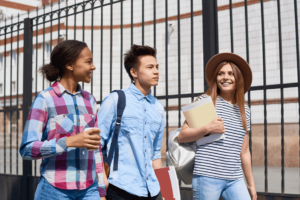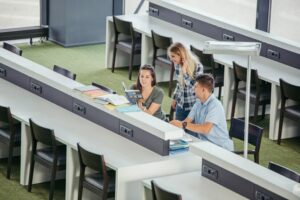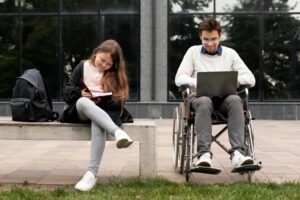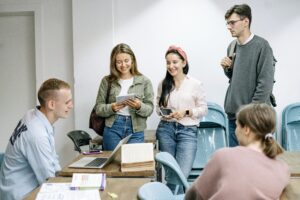Fostering Equal Value in HEI Classrooms
Materials
1. Introduction
In the field of education and professional development, the quest for inclusivity stands as a cornerstone for nurturing diverse and thriving communities. The following text delves into a comprehensive exploration of strategies and considerations essential for promoting inclusivity and enriching learning environments. It begins by outlining key criteria to measure the inclusiveness of a class, emphasizing aspects like listening, the working environment, problem-solving, flexibility, and team-building activities. Moving forward, it delves into the importance of teaching “difference” and embracing diversity, challenging stereotypes and biases while exploring perceptions of ability and disability. The text further discusses overcoming inequity through setting high expectations for all students and providing differentiated support. Augmentative and Alternative Communication (AAC) systems are highlighted as crucial tools for ensuring communication access for individuals with disabilities. Additionally, the text explores the benefits of mind mapping in enhancing learning and group work in fostering collaboration, communication skills, problem-solving abilities, social development, cooperation, conflict resolution skills, risk-taking behavior, and new perspectives among students. Accessibility considerations like color contrast are also addressed to ensure readability for all learners. Through these insights, the text aims to shed light on the multifaceted approach required to create inclusive environments where every individual has the opportunity to thrive and succeed (Walters, 2010).
The promotion of inclusivity in educational settings is a fundamental aspect of fostering diverse and thriving communities. By embracing differences and creating environments where all voices are heard, we can cultivate spaces where everyone feels valued and empowered to contribute. Let’s delve into various strategies and considerations for promoting inclusivity and enhancing learning environments.
2. Understanding Inclusivity: Key Criteria for Measurement
To assess the inclusiveness of a class, several criteria must be considered. These include:
- Listening: Can students express themselves freely, and are they actively listened to?
- Problem Solving: Are conflicts within the team resolved promptly through sharing feelings to enhance understanding?
- Flexibility: Is there openness to flexible working arrangements like following class online?
- Activities: Does the school offer team-building activities to boost motivation and foster a sense of belonging?
2.1. Listening:
In an inclusive classroom, the art of listening extends beyond the mere act of hearing words. It encompasses active engagement with the speaker, an empathetic understanding of their perspective, and a genuine respect for their contributions. Teachers cultivate an environment where every student feels not just heard, but truly understood and valued. They model effective listening behaviors, such as maintaining eye contact, nodding to show understanding, and asking clarifying questions. Moreover, teachers encourage students to express themselves freely, fostering a culture of open communication and mutual respect. By prioritizing active listening, educators lay the foundation for meaningful dialogue, deeper connections, and enhanced learning experiences.
2.2. Problem Solving:
Conflict resolution is more than just resolving disputes; it’s an opportunity for personal growth, empathy building, and relationship strengthening. Inclusive classrooms embrace conflicts as teachable moments, where students learn to navigate differences of opinion, negotiate solutions, and cultivate empathy for others. Teachers guide students through the problem-solving process, encouraging them to identify underlying issues, express their feelings constructively, and collaborate towards mutually beneficial resolutions. By fostering a culture of empathy and understanding, educators equip students with essential life skills for navigating diverse social environments and building positive relationships.
2.3. Flexibility:
Flexibility in education is a cornerstone of inclusive practices, ensuring that every student has equitable access to learning opportunities. It involves adapting instructional strategies, accommodating diverse learning needs, and embracing alternative approaches to traditional classroom settings. Inclusive educators recognize that one size does not fit all and strive to create personalized learning experiences that cater to the individual needs and circumstances of each student. Whether it’s offering online learning options, providing flexible deadlines, or adjusting assignments to accommodate different learning styles, flexibility promotes inclusivity by removing barriers to learning and empowering every student to succeed.
2.4. Activities:
Team-building activities are more than just fun and games; they are powerful tools for fostering a sense of belonging, cooperation, and mutual respect within the classroom. Inclusive educators design activities that encourage collaboration, communication, and problem-solving skills while celebrating diversity and promoting inclusivity. From icebreaker games that break down social barriers to group projects that encourage peer support and collaboration, these activities create opportunities for students to connect with one another on a deeper level. Moreover, team-building activities promote a positive classroom climate where students feel valued, supported, and motivated to participate actively in their own learning journey (Walters, 2010).
3. Teaching Inclusivity: Embracing Diversity
Inclusive educators deeply comprehend that diversity transcends superficial markers such as race, ethnicity, or gender; it encapsulates the rich tapestry of human experiences, perspectives, and identities that each individual brings to the learning environment. They go beyond mere tolerance to actively celebrate and embrace this diversity, understanding that it enriches the educational experience for all. These educators meticulously craft learning environments characterized by safety, respect, and empowerment, where students feel not only accepted but truly valued for their authentic selves. Through thoughtfully designed curriculum, thought-provoking discussions, and hands-on learning experiences, educators challenge ingrained stereotypes, broaden perspectives, and instill a sense of empathy and social responsibility in their students. By fostering a culture where diversity is not only acknowledged but celebrated as a fundamental strength, inclusive educators cultivate an atmosphere of inclusivity where every student feels acknowledged, understood, and appreciated for the unique contributions they bring to the table (Taylor, 2016).
3.1. Overcoming Inequity: Lessons Learned and Solutions Explored
Efforts to overcome inequality in education emphasize setting high expectations for all students and providing differentiated levels of support to ensure fairness in achieving those expectations. Recognizing the voices of individuals with disabilities is crucial in shaping inclusive policies and practices. Augmentative and Alternative Communication (AAC) systems play a vital role in ensuring communication access for individuals with disabilities.
3.2. Enhancing Learning through Mind Mapping and Group Work
Mind mapping is a hierarchical visualization technique that enhances learning by helping individuals organize and connect ideas1. Online tools like Cmap, MindMeister, Lucidchart, Bubbl.us, or Zapier facilitate the creation of mind maps. Group work fosters collaboration, communication, problem-solving skills, individual achievement, social development, cooperation, conflict resolution skills, risk-taking behavior, and new approaches to resolving differences among students (Gyasi, Okrah and Anku, 2020).
3.3. Harnessing the Power of Mind Mapping
Mind mapping transcends its role as a mere study aid; it stands as a powerful cognitive tool that actively engages learners in the process of knowledge acquisition and synthesis. Inclusive educators recognize its potential to foster active learning, critical thinking, and creativity among students. By harnessing the dynamic nature of mind mapping, educators facilitate the organization of complex information, the identification of interconnections between ideas, and the synthesis of knowledge into coherent frameworks. They provide students with opportunities to engage in the creation of their own mind maps, encouraging them to visually express their thoughts, explore diverse perspectives, and collaborate with peers in the co-construction of knowledge. Through the integration of mind mapping into their teaching practices, educators empower students to assume ownership of their learning journey, cultivate metacognitive skills, and attain deeper levels of comprehension and proficiency across various subject areas.
3.4. Collaborative Learning: A Cornerstone of Education
A Cornerstone of Education: Collaborative learning is not just about working together on group projects; it’s about fostering a culture of cooperation, communication, and shared responsibility in the classroom. Inclusive educators recognize the value of collaborative learning in promoting social-emotional development, critical thinking skills, and academic achievement. They design collaborative activities that encourage active participation, peer interaction, and collective problem-solving. Moreover, they create a supportive learning environment where students feel safe to take risks, share ideas, and learn from one another. By embracing collaborative learning as a cornerstone of education, educators empower students to become lifelong learners, effective communicators, and compassionate members of society (Walters, 2010).
3.5. Color and Contrast:
Contrast sensitivity refers to the ability to distinguish the brightness disparity between foreground and background colors. The perception of size, distance, and illumination of an object varies based on the level of contrast present. This sensitivity is crucial for reading text and viewing visuals clearly. It’s essential to ensure that graphical and textual elements exhibit adequate contrast with the background. Particular caution should be exercised with patterned or pictorial backgrounds, as they can hinder text legibility (Taylor, 2016).
To optimize contrast, opt for dark text on light backgrounds. When applying a tint to the background, aim for tints between 10 and 15%. Avoid using text as a 10 to 15% tint of a solid color over a white, cream, or pastel background, as it becomes nearly impossible to discern. If employing a dark background, ensure the text is in a white or very pale shade. Steer clear of utilizing color-on-color overlays, as they are not suitable for individuals with vision impairments.
4. Universal Design for Learning (UDL)
Universal Design for Learning (UDL) is an educational framework aimed at ensuring that all students have equal opportunities to learn by creating flexible learning environments. At its core, UDL emphasizes three key principles: Multiple Means of Representation (MMR), Multiple Means of Engagement (MME), and Multiple Means of Expression (MME).
MMR focuses on presenting information in various formats to cater to diverse learning styles and preferences. This might include visual aids like diagrams, auditory explanations such as lectures or podcasts, tactile materials like models, and interactive multimedia. By providing multiple representations, educators ensure that information is accessible to students with different learning needs (Taylor, 2016).
MME recognizes that students have different interests, motivations, and levels of engagement. Educators can enhance engagement by offering choices in learning activities, incorporating hands-on experiences, making lessons relevant to real-world contexts, and fostering collaboration among students. By tapping into students’ interests and providing multiple pathways for engagement, educators can increase motivation and investment in learning.
MME emphasizes offering students various ways to demonstrate their understanding and express their knowledge. This could involve written assignments, oral presentations, multimedia projects, demonstrations, or performances. By providing options for expression and accommodating diverse strengths and preferences, educators empower students to showcase their understanding in meaningful ways (Gyasi, Okrah and Anku, 2020).
Overall, UDL encourages educators to design learning experiences that are flexible, inclusive, and responsive to the diverse needs of all learners. By incorporating multiple means of representation, engagement, and expression, educators can create dynamic and accessible learning environments where every student can thrive (Walters, 2010)
5. Conclusion and Recommendations
In conclusion, the journey towards inclusivity in educational and professional settings is a multifaceted endeavor that demands a holistic approach. By embracing diversity, fostering open communication, and addressing inequities, organizations can create environments where every individual feels valued and empowered to contribute meaningfully. Drawing from the criteria outlined to measure inclusiveness, it is evident that active listening, adaptable working environments, effective problem-solving strategies, flexibility in work arrangements, and engaging team-building activities are vital components for promoting inclusivity within a team or project (Gyasi, Okrah and Anku, 2020).
Recommendations for enhancing inclusivity and learning environments include:
- Prioritize Active Listening: Encourage an environment where all voices are heard and valued, fostering open communication channels.
- Embrace Diversity: Promote understanding and celebration of differences to challenge stereotypes and biases within the team.
- Address Inequities: Set high expectations for all individuals while providing differentiated levels of support to ensure fairness in achieving those expectations.
- Utilize AAC Systems: Implement Augmentative and Alternative Communication (AAC) systems to ensure communication access for individuals with disabilities.
- Enhance Learning through Group Work: Encourage group work to foster collaboration, communication skills, problem-solving abilities, social development, and new perspectives among students.
- Mind Mapping Tools: Utilize mind mapping tools like Cmap, MindMeister, Lucidchart, Bubbl.us, or Zapier to enhance learning by organizing and connecting ideas effectively.
- Consider Accessibility: Ensure readability for all learners by adhering to color contrast guidelines and providing accessible materials.
- integrating these recommendations into organizational practices and educational approaches, we can create inclusive environments that empower individuals to thrive and succeed while fostering a culture of respect, understanding, and collaboration.
6. References
Gyasi, M. N. K., Okrah, A. K., & Anku, J. S. A. (2020). Teachers’ Knowledge of Special Educational Needs and Disability Students and Their Classroom Management Approaches. World Journal of Education, 10(4), 160-172.
https://eric.ed.gov/?id=EJ1266948
Taylor, M. A. (2016). Improving accessibility for students with visual disabilities in the technology-rich classroom. PS: Political Science & Politics, 49(1), 122-127.
Walters, S. (2010). Toward an accessible pedagogy: Dis/ability, multimodality, and universal design in the technical communication classroom. Technical Communication Quarterly, 19(4), 427-454.
https://www.tandfonline.com/doi/abs/10.1080/10572252.2010.502090
6. Pedagogy: Implementation in the classroom
Inclusive Digital Teaching Practices
Technical support for teachers (PSR 5.7)
10 min
After this unit, you will be able to:
- recognize if all students feel equally valued and mutually respects
- facilitate the organization of teaching groups by digital technologies in which students can collaborate by valuing the diversity of each one
respectful classroom environment, inclusive classroom, respect, trust, teaching groups, collaboration, diversity, support, equality, discrimination to be improved after development of unit








Funded by the European Union. Views and opinions expressed are however those of the author(s) only and do not necessarily reflect those of the European Union or the European Education and Culture Executive Agency (EACEA). Neither the European Union nor EACEA can be held responsible for them (2022- 1 -SI01 -KA220-HED-000088368).






